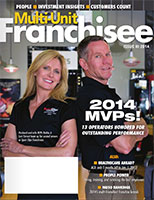End of the Bond Bull?: How to Manage the Nearing Possibility

For the past 30 years, the U.S. has experienced the longest bull market on record for fixed-income securities. As interest rates declined, investors in bonds benefited. Fixed-income returns have been far above historical norms, even outperforming stocks during crucial periods, and investors have poured billions into them. The seemingly inevitable end of this run has many investors uncertain about the future.
There has been a great deal of debate recently regarding the notion that interest rates, which are hovering near all-time lows, may be set to increase, particularly as a result of the massive amounts of stimulus provided by central banks worldwide in the wake of the 2008 financial crisis. What about the Fed's balance sheet? What will the impact be if quantitative easing continues? What are the ripple effects that may be caused if investors create a disorderly exit? Given the complexity of the issues, we can touch only on a few points here.
Debt in the U.S. has risen sharply in the past 30 years: total credit market instruments now amount to more than 3.5 times the size of the U.S. economy as measured by GDP. At first, it happened gradually. In the wake of the Great Depression and WWII, several generations of Americans had an ingrained aversion to debt. Then laws changed, and "debt" became "credit" and credit became easier to obtain. For a while the tax code favored debt and spending over savings or investment. But the real upswing in appetite came when Wall Street figured out how to spread the potential credit risk by packaging pools of debt (mortgages and auto, credit card, and student loan receivables). Aging Baby Boomers liked these pooled vehicles because they often provided high yields.
Throughout this period, inflation was coming down and so were bond yields. Investors were also attracted to fixed-income investments, especially in the wake of volatile stock markets. At the end of 2012, more than $1 trillion was invested in bond funds. With rates near zero and the Fed working to get a moderate amount of inflation back into the system, many are asking, "When does the bull end?"
As with so many investment topics, the answer is more nuanced than most pundits spell out. First, inflation and bond yields don't mean the same thing. In the wake of the 2008 financial crisis, the Fed and other global central banks flooded the world market with liquidity. The pundits feared that such great quantities of stimulus would automatically lead to inflation. But inflation is a product not only of the quantity of funds in the global system, but more important, of how rapidly those funds move in the system (velocity). Pumping funds into a system that end up sitting on balance sheets or in bank accounts rather than being spent doesn't do much to push inflation upward. Nor, incidentally, does it propel GDP robustly... as we've seen throughout the nearly 6 years of post-meltdown "recovery."
Interest rates, on the other hand, can be influenced by a variety of things, including collective expectations of where inflation might be in the future. Rates at the short end of the yield curve have been artificially depressed for years by the Fed's monetary policy. More recently, the Fed's quantitative easing program has worked to keep longer-term interest rates lower than fundamentals would have necessarily predicted. Finally, when investors get fearful over things like unruly stock markets or geopolitical tensions, they still knee-jerk jump into fixed income, which pushes yields down (not because inflation dropped, but because demand for the bonds increased).
This artificially low interest rate environment has caused investors to go on a global search for yield. In the process, many have discounted potential risk in the assets they are buying. Risk and return are always related, but there are times when potential risk is underappreciated. There are times when investors are oversensitive as well (stock market lows in 2003 and 2009). Investors in fixed income should be careful to stick to long-term investment basics as they search for suitable investments. Here are a few suggestions to start the thought process:
- Get your head wrapped around the fact that there's no silver bullet. If something's carrying a higher yield, there's risk (credit, liquidity, volatility) in it somewhere.
- Choose individual bonds over bond funds for principal protection (presuming high-credit quality of the underlying issuer).
- Ladder bond maturities to prevent overexposure to a particular time frame.
- Keep durations shorter--and remember that the Fed is intervening along the entire curve. When it stops and rates snap up, it happens with more force at the longer ends.
- Be willing to realize losses and swap bonds if rates do start to rise, especially if you can use the loss to offset gains elsewhere.
- Understand that fixed income still has a purpose in many portfolios despite low historic yields.
- Munis, especially for those in high tax brackets or from high-tax states, can be interesting.
- Look to floating rates, bank loans, and other variable rate instruments (understanding the extra risk involved; these are not money market substitutes).
- Consider high-quality, dividend-paying stocks. They can generate a stream of revenue that keeps up with inflation as many companies raise their dividends above the rate of inflation each year.
These are just a few points on how an investor should review the possibility of the end of fixed-income investments. For more detail on this, read my white paper, End of the Bond Bull, located on the Insights page of www.abbotdowning.com.
Carol M. Schleif, CFA, is regional chief investment officer at Abbot Downing, a Wells Fargo business that provides products and services through Wells Fargo Bank, N.A. and its affiliates and subsidiaries. She welcomes questions and comments at carol.schleif@abbotdowning.com.
Share this Feature
Recommended Reading:
Comments:
comments powered by DisqusFRANCHISE TOPICS
- Multi-Unit Franchising
- Get Started in Franchising
- Growth
- Operations
- Open New Units
- Leadership
- Marketing
- Technology
- Legal
- Awards
- Rankings
- Trends
- Featured Franchise Stories
FEATURED IN

Multi-Unit Franchisee Magazine: Issue 3, 2014
$100,000
$690,200




 The multi-unit franchise opportunities listed above are not related to or endorsed by Multi-Unit Franchisee or Franchise Update Media Group. We are not engaged in, supporting, or endorsing any specific franchise, business opportunity, company or individual. No statement in this site is to be construed as a recommendation. We encourage prospective franchise buyers to perform extensive due diligence when considering a franchise opportunity.
The multi-unit franchise opportunities listed above are not related to or endorsed by Multi-Unit Franchisee or Franchise Update Media Group. We are not engaged in, supporting, or endorsing any specific franchise, business opportunity, company or individual. No statement in this site is to be construed as a recommendation. We encourage prospective franchise buyers to perform extensive due diligence when considering a franchise opportunity.